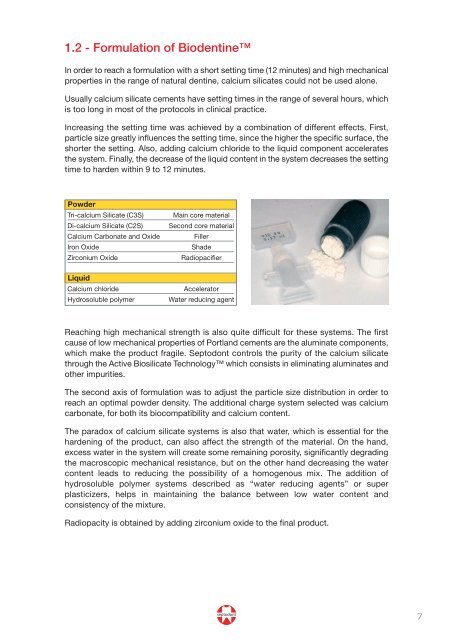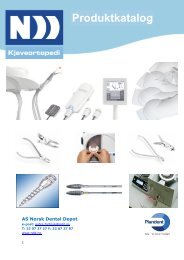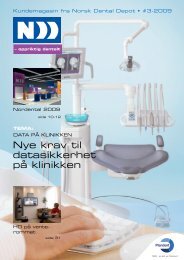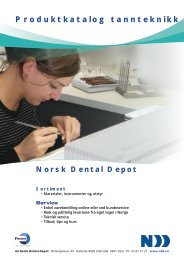Biodentine
Biodentine
Biodentine
Create successful ePaper yourself
Turn your PDF publications into a flip-book with our unique Google optimized e-Paper software.
1.2 - Formulation of <strong>Biodentine</strong><br />
In order to reach a formulation with a short setting time (12 minutes) and high mechanical<br />
properties in the range of natural dentine, calcium silicates could not be used alone.<br />
Usually calcium silicate cements have setting times in the range of several hours, which<br />
is too long in most of the protocols in clinical practice.<br />
Increasing the setting time was achieved by a combination of different effects. First,<br />
particle size greatly influences the setting time, since the higher the specific surface, the<br />
shorter the setting. Also, adding calcium chloride to the liquid component accelerates<br />
the system. Finally, the decrease of the liquid content in the system decreases the setting<br />
time to harden within 9 to 12 minutes.<br />
Powder<br />
Tri-calcium Silicate (C3S) Main core material<br />
Di-calcium Silicate (C2S) Second core material<br />
Calcium Carbonate and Oxide Filler<br />
Iron Oxide Shade<br />
Zirconium Oxide Radiopacifier<br />
Liquid<br />
Calcium chloride Accelerator<br />
Hydrosoluble polymer Water reducing agent<br />
Reaching high mechanical strength is also quite difficult for these systems. The first<br />
cause of low mechanical properties of Portland cements are the aluminate components,<br />
which make the product fragile. Septodont controls the purity of the calcium silicate<br />
through the Active Biosilicate Technology which consists in eliminating aluminates and<br />
other impurities.<br />
The second axis of formulation was to adjust the particle size distribution in order to<br />
reach an optimal powder density. The additional charge system selected was calcium<br />
carbonate, for both its biocompatibility and calcium content.<br />
The paradox of calcium silicate systems is also that water, which is essential for the<br />
hardening of the product, can also affect the strength of the material. On the hand,<br />
excess water in the system will create some remaining porosity, significantly degrading<br />
the macroscopic mechanical resistance, but on the other hand decreasing the water<br />
content leads to reducing the possibility of a homogenous mix. The addition of<br />
hydrosoluble polymer systems described as “water reducing agents” or super<br />
plasticizers, helps in maintaining the balance between low water content and<br />
consistency of the mixture.<br />
Radiopacity is obtained by adding zirconium oxide to the final product.<br />
7















